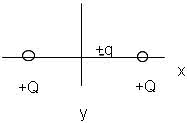ART 320 Quiz: Sheet 1
Document Summary
The smallest unit of charge is the electron charge (e= 1. 6 x 10-19 c), c is shortcut for coulomb. So the electric charge of a body can be represented by the rule: q= ne q is total charge of a body. N is number of electron. e is the electron charge. Coulomb"s law for the electrostatic force between electric charge. We call electrostatic as the charge is at rest (don"t move). f =k q1 q2 r2 unit of the force is newton(n) K= 9 x 109 nm2/c2 is coulomb"s constant. q1q2 is the electric charges. r is the distance between q1 and q2. It also called the inverse square law because the force inversely proportional to the square distance between q1 and q2. If q1q2 product is positive, this means q1 and q2 have the same charge either positive or negative, and resulting force is repulsive force.

